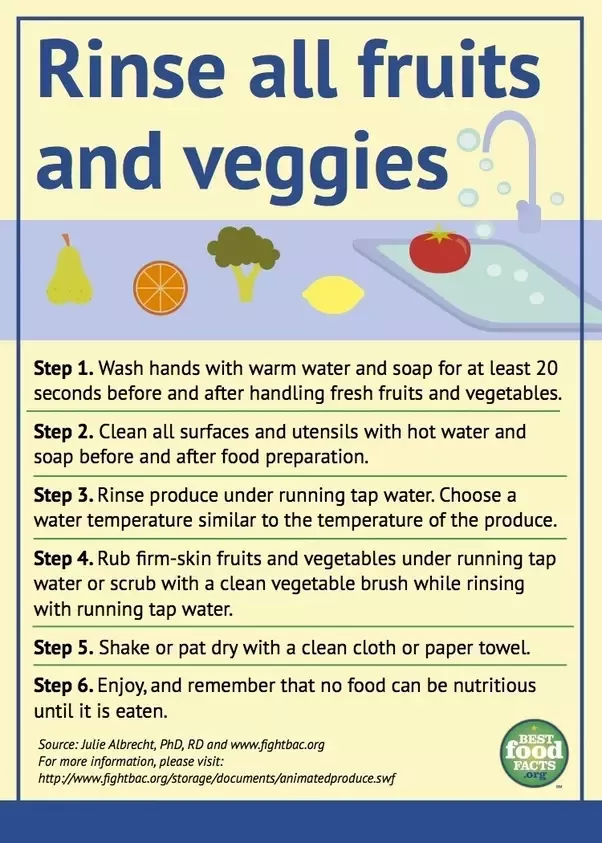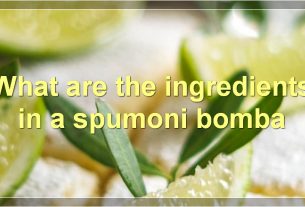Have you ever bitten into a succulent grape, only to discover a hidden world of bacteria lurking in its skin?
Well, fear not!
In this article, we will unravel the mystery of how to properly wash these delicious fruits without sacrificing their freshness.
Get ready to tantalize your taste buds while keeping those pesky microbes at bay!
how to wash grapes
To wash grapes, start by emptying them into a colander and rinsing them with cool water.
Make sure to move them around to clean all sides.
If desired, sprinkle a little baking soda and/or salt on the grapes and gently scrub to remove the bloom.
Rinse off the baking soda and/or salt with cool water.
After washing, let the grapes dry completely to prevent excess moisture that can lead to faster spoiling.
Store the grapes in a ventilated bag in the refrigerator to preserve them for up to three weeks.
It’s best to not wash grapes until right before eating to avoid moldy or inedible grapes.
Unwashed grapes can harbor viruses and bacteria such as salmonella, E.
coli, and Listeria.
Key Points:
- Empty grapes into colander and rinse with cool water
- Move grapes around to clean all sides
- Optionally, sprinkle baking soda and/or salt on grapes and scrub to remove bloom
- Rinse off baking soda and/or salt with cool water
- Let grapes dry completely to prevent excess moisture
- Store grapes in ventilated bag in refrigerator for up to three weeks
how to wash grapes – Watch Video
💡
Pro Tips:
1. Grapes have a natural protective layer called bloom, which is actually a waxy coating that helps preserve their freshness. Washing grapes too vigorously can remove this protective layer, so it’s best to wash them gently.
2. Did you know that grapes can freeze well? If you have excess grapes and don’t want them to go to waste, simply wash and dry them, then place them in a single layer on a baking sheet and freeze. Once they’re frozen, transfer them to a freezer-safe bag or container for future use.
3. Grapes are not only delicious but also a great source of hydration! With an average water content of 80%, eating grapes can help keep you hydrated, especially during hot summer days.
4. Small white spots on the surface of grapes are harmless and natural. These spots, known as lenticels, are similar to pores on the skin and are responsible for gas exchange, allowing the grape to “breathe.” So, no need to worry if you see them!
5. Despite their small size, grapes are bursting with nutritional goodness. They are loaded with antioxidants, such as resveratrol, which has been linked to various health benefits, including heart health and potentially even longevity. So, eating grapes not only satisfies your taste buds but also supports your overall well-being!
Grapes And The Dirty Dozen: The Pesticide Problem
Grapes, a delicious and nutritious fruit, have become a concern due to their association with the Dirty Dozen list, which identifies produce with high pesticide levels. This means that extra precautions should be taken when handling and consuming grapes.
Pesticides are commonly used in conventional farming to protect crops from pests and diseases. Unfortunately, these chemicals can potentially pose health risks to consumers, especially if consumed in large quantities over a long period of time. To reduce exposure to pesticides, the Environmental Working Group (EWG), a non-profit organization focused on environmental health, suggests purchasing organic grapes. However, it is important to note that organic produce can be more expensive, which may be a financial consideration for some individuals.
- Grapes may have high pesticide levels and are listed on the Dirty Dozen.
- Pesticides can pose health risks, particularly when consumed in large quantities.
- The EWG recommends buying organic grapes to reduce pesticide exposure.
- Cost is a factor to consider when purchasing organic produce.
Weighing The Organic Option: Cost Vs. Health
When buying organic grapes, there is an ongoing debate regarding the health benefits and higher cost associated with them. Organic grapes are grown without synthetic pesticides, fertilizers, or genetically modified organisms, reducing the risk of pesticide residue on the fruit and offering potential health advantages.
However, it is important to note that organic grapes can be considerably more expensive compared to conventionally grown grapes. This price difference may pose a challenge for those on a tight budget who want to consistently opt for organic options. Therefore, it is advisable to carefully consider the health benefits and weigh them against the financial impact before deciding whether to purchase organic grapes.
To summarize:
- Organic grapes are grown without synthetic pesticides, fertilizers, or genetically modified organisms.
- This reduces the risk of pesticide residue on the fruit and provides potential health advantages.
- However, organic grapes can be significantly more expensive than conventionally grown grapes.
- It is recommended to consider the health benefits and weigh them against the financial impact before making a decision.
“It is recommended to consider the health benefits and weigh them against the financial impact when deciding whether to purchase organic grapes.”
Moisture Matters: Washing Grapes And Decomposition Risks
When it comes to washing grapes, there are a few things to keep in mind to maintain their freshness and quality:
-
Handle with care: Grapes are delicate fruits that easily absorb water. Be gentle when handling them to prevent bruising or damaging the fruit.
-
Wash only what you need: To minimize moisture exposure, it is advisable to wash only the grapes you plan to consume immediately or in the near future. This helps to maintain their freshness and extend their shelf life.
-
Wash in small batches: If you have a large quantity of grapes, it’s best to wash them in smaller batches. By doing so, you avoid unnecessary moisture exposure and reduce the risk of spoilage.
-
Pat dry: After washing the grapes, gently pat them dry with a clean towel or paper towel. Removing excess moisture helps to prevent decomposition and maintain their quality.
In conclusion, proper washing of grapes involves handling them with care, washing only what you need, washing in small batches, and patting them dry to prevent excess moisture. Following these tips will help prolong the shelf life and maintain the quality of your grapes.
Timing Is Key: Washing Grapes For Immediate Consumption
To maintain the freshness and quality of grapes, it is recommended to wash them right before eating or using them in recipes. This prevents the growth of mold or the grapes becoming inedible due to excessive moisture. By practicing this simple tip, you can ensure that your grapes are clean, safe to eat, and remain fresh for a longer duration.
- Wash grapes right before consuming or using in recipes
- Prevents mold growth and excessive moisture
- Ensures grapes are clean, safe to eat, and fresh for longer duration
By washing grapes before consumption, you can protect their freshness and quality.
The Protective Bloom: Understanding The Waxy White Film
Have you ever wondered about the waxy white film on the surface of grapes? This layer, known as the bloom, plays a vital role in preserving their freshness. The bloom acts as a natural protective barrier, preventing moisture loss and warding off potential pathogens.
It is important not to remove the bloom prematurely or excessively during the washing process. Only scrubbing lightly will suffice to clean the grapes while still retaining some of the protective bloom. By preserving this natural coating, you can extend the shelf life of the grapes and maintain their taste and quality.
Step By Step: Properly Washing Grapes In A Colander
To properly clean your grapes, follow these steps using a colander:
-
Remove any stems or debris from the grapes and place them in the colander.
-
Rinse the grapes under cool water, gently moving them around to ensure all sides are cleaned.
-
Be cautious not to soak the grapes excessively or damage their delicate skin while rinsing.
-
Inspect the grapes for dirt or blemishes after rinsing. Discard any damaged or moldy grapes.
Remember, using a colander is the ideal tool for washing grapes, ensuring they are properly cleaned and free from any unwanted debris.
Scrubbing Away The Bloom: Using Baking Soda And Salt
If you prefer to remove the protective bloom from the grapes, you can use a gentle scrubbing method. Sprinkle a small amount of baking soda and/or salt onto the grapes. Using your hands, lightly scrub the grapes, paying attention to each grape’s surface.
Baking soda and salt act as natural cleansers and can effectively remove the wax-like bloom. However, it is important to note that this step is optional and should only be done if you prefer to remove the bloom or if you are concerned about any potential contaminants present.
- Use a gentle scrubbing method to remove the grape’s protective bloom:
- Sprinkle a small amount of baking soda and/or salt onto the grapes.
- Lightly scrub the grapes, paying attention to each grape’s surface.
Rinse And Dry: Removing Baking Soda And Salt Residue
Once you have finished scrubbing the grapes with baking soda and/or salt, it is essential to rinse off any residue thoroughly. Rinse the grapes under cool running water, ensuring that all the baking soda and salt are removed.
After rinsing, carefully inspect the grapes again to ensure no visible residue remains. Once you are satisfied, gently pat the grapes dry with a clean dish towel or paper towel.
Drying Thoroughly: Reducing Spoilage Risks After Washing
Excess moisture can accelerate the spoilage process of grapes. To minimize the risk of spoilage, it is crucial to let the grapes dry thoroughly after washing.
Here are some steps to follow for drying grapes properly:
- Spread them out on a clean dish towel or paper towel
- Allow them to air dry completely before consuming or storing.
By taking the time to dry the grapes properly, you can prevent any unwanted moisture from being trapped, ensuring the grapes remain fresh and flavorful for an extended period.
To summarize:
1. Excess moisture can spoil grapes.
2. Dry grapes thoroughly after washing.
3. Spread them out on a clean dish towel or paper towel.
4. Allow them to air dry completely.
Preserving Freshness: Proper Storage To Prolong Grape Lifespan
Proper storage is key to preserving the freshness and extending the lifespan of washed grapes. After the grapes have dried completely, they should be stored in a ventilated bag in the refrigerator. This will help maintain their quality and taste for up to three weeks.
Be sure not to wash grapes until you are ready to consume them to avoid any potential mold growth or compromising their quality. Washing unwashed grapes before eating is essential, as they can harbor viruses and bacteria such as salmonella, E. coli, and Listeria.
In conclusion, washing grapes is an important step to ensure safe consumption. While they fall into the Dirty Dozen list due to their pesticide content, there are steps you can take to reduce exposure. By understanding the risks of moisture, preserving the protective bloom, and following a proper washing and drying process, you can enjoy clean and safe grapes while maximizing their freshness and taste. Remember to consider the benefits and costs of organic options, as well as the importance of storing grapes correctly for prolonged enjoyment.
💡
You may need to know these questions about how to wash grapes
What is the best thing to wash grapes in?
The best thing to wash grapes in is a solution of lukewarm water mixed with baking soda or salt. These natural ingredients can effectively remove the bloom from the grapes without leaving any harmful residues. It is crucial to avoid using soap or detergents, as they can leave behind a film that may be unsafe for consumption. Overall, opting for baking soda or salt as a gentle scrubbing agent ensures clean and safe grapes to enjoy.
Should I wash grapes with vinegar or baking soda?
Both vinegar and baking soda can be effective in cleaning grapes, depending on personal preference and availability. If you have vinegar in your pantry, it can be used to wash grapes, as it helps remove dirt, residue, and some bacteria effectively. However, if you also have baking soda on hand, you can consider using it as well, as it is an excellent ingredient for cleaning grapes and can provide additional benefits. Baking soda has natural cleaning properties that can help remove dirt and pesticides from the grapes, making it a great alternative to vinegar. Ultimately, the choice between vinegar and baking soda comes down to personal preference and what you have readily available in your kitchen.
How long do you soak grapes to clean them?
To adequately clean grapes, it is recommended to let them soak in water for around 5 minutes. During this time, the water helps loosen any dirt or residues on the grapes’ surface. After allowing them to soak, use your hands to lightly rub the grapes, removing any remaining film. To finish, thoroughly rinse the grapes with water, carefully dry them with a paper towel, and they are ready to be enjoyed.
Should I soak grapes in vinegar?
Soaking grapes in vinegar can be a beneficial step in maintaining their freshness. By placing grapes in a bowl filled with water and vinegar, you can effectively kill mold spores that may be present. This simple technique ensures that your grapes remain clean and safe to consume, providing an extra layer of protection. So, if you want to prolong the shelf life of your grapes and enjoy them without any worries, soaking them in vinegar is a great option.
Reference source
https://www.realsimple.com/food-recipes/shopping-storing/food/how-to-wash-grapes
https://www.youtube.com/watch?v=eloyo0tf22g
https://www.sun-world.com.au/how-to/wash-grapes
https://www.tasteofhome.com/article/how-to-wash-grapes/



